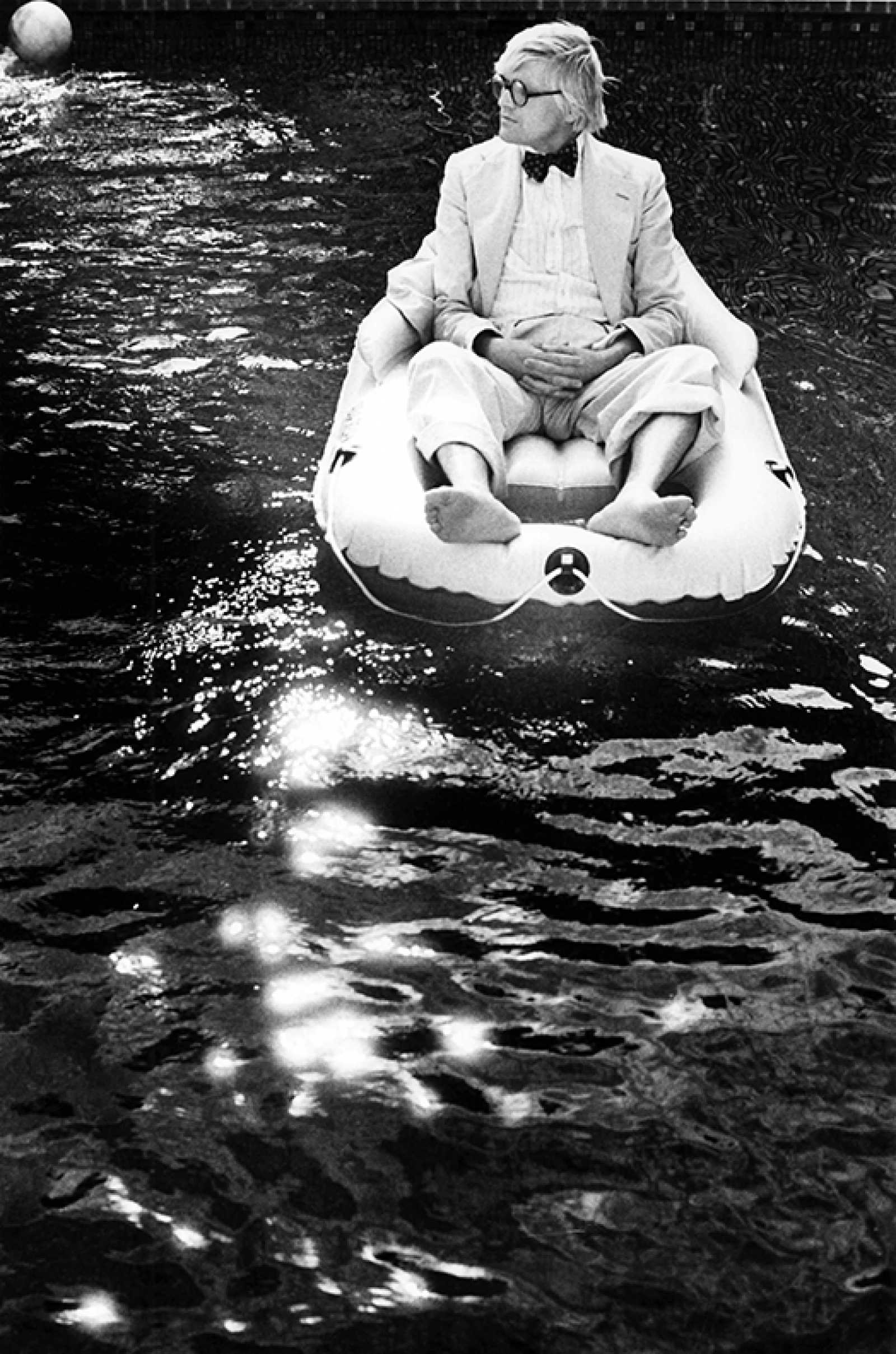Michael Childers
Since the 1960s, Michael Childers has been producing photographic portraits of famous people. His long connection to the world of celebrity has given him access to many iconic film stars, artists, and writers of our time—particularly those who make up the creative culture of Southern California and those with ties to Palm Springs. His subjects have included Andy Warhol, David Hockney, E. Stewart Williams, Sissy Spacek, Demi Moore, Ringo Starr, and numerous others. As a local resident and supporter of the museum’s photography program, Childers has been an important contributor to the collection—donating his own works and those of his friends and colleagues.
Childers has been photographing artist David Hockney since their friendship began in 1968. The swimming pool is a recurring subject of Hockney’s paintings. For his portrait Hockney at Rising Glen, Childers asked Hockney to dress in a white suit and sit in an inflated raft in Childers’ Hollywood Hills swimming pool. Hockney appears casual and relaxed. As the viewer’s eye scans the surface of the surrounding water, it is drawn to the ball in the upper left corner.
Childers received his first camera at age 14 and provided photographs for his high school newspaper. In 1962, he moved to Los Angeles to study at UCLA. To support himself, he photographed celebrity musicians and actors, crediting Hollywood photographer George Hurrell as a major influence. His personal relationship and work with filmmaker John Schlesinger, beginning in 1968, also had a major influence on his life and career. Childers moved to Palm Springs in 1998 where he continues to live and work.
Michael Childers, David Hockney at Rising Glen, Hollywood, 1978, gelatin silver print, 16 x 20 inches. Gift of the artist, 47-2004.
Claire Falkenstein
Through her long career, Claire Falkenstein explored a variety of media in her sculpture, drawings, paintings, prints, and jewelry. An Oregon native, she received her BA degree from UC Berkeley in 1930, and in 1933 received a grant to study with artist Alexander Archipenko at Mills College in Oakland. Inspired by the work of such artists as Naum Gabo and László Moholy-Nagy, Falkenstein began her career working mainly with clay to create abstract ceramic sculptures. However, in the 1940s, she began working with other materials—sheet aluminum, wire, glass, and plastic—and after meeting artists Richard Diebenkorn and Clyfford Still, she began to produce paintings.
Changing Dimensions, an early painting, confronts the viewer with a multitude of discontinuous abstract shapes. The overlapping planar elements, charged with dynamic diagonal lines, offer tangible form to the intangible concepts of time and motion. In a non-illusionistic manner, this work conveys a sense of depth. The lines form one spatial plane, the shapes exist in another, while the red background creates a sense of deep spatial void. This painting was included in the 1950 exhibition American Painting Today at the Metropolitan Museum of Art in New York.
In 1950 Falkenstein moved her studio to Paris where she began creating open wire sculptures that foregrounded the presence of negative space, establishing the aesthetic vocabulary that she would continue to use throughout her career. While in Paris, Falkenstein associated with Jean Arp and Alberto Giacometti and joined a group of artists that included the American Abstract Expressionists Sam Francis and Paul Jenkins. While in Europe, Falkenstein created several large-scale commissions, including the gates of the eighteenth-century Palazzo Venier de Leoni, which now houses the Peggy Guggenheim Collection, Venice (1961). She relocated to Venice, California in 1963, and executed a number of monumental sculptures in Los Angeles as well as commissions in the Southern California region, including Palm Springs. Later in life, Falkenstein abandoned large, physically demanding metal sculptures and returned to painting until her death in 1997.
Claire Falkenstein (American, 1908-1997), Changing Dimensions, 1948, oil on canvas, frame painted by artist, 36 x 41 inches. Gift of the Falkenstein Foundation, 16-2010.


